4WD Northern Namibia: Camping on the Huab River
Traveling overland 5,000 miles from Cape Town, Sarah Duff discovers a remote area of Damaraland, in northwestern Namibia, where desert elephants roam freely.
Shares
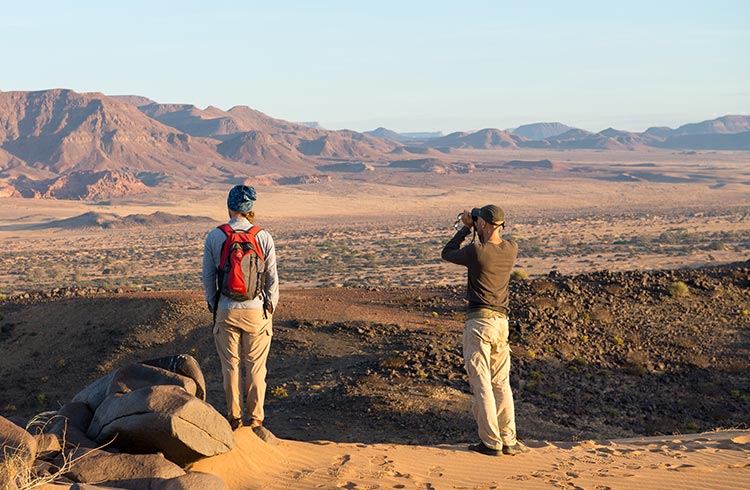 Photo © Sarah Duff
Photo © Sarah Duff
The sunset casts a pink glow across the sky as the chirps of barking geckos mark the end of another day in the desert. We stand in contemplative silence, sipping dusty cans of beer as, just 600 feet away from us, a family of elephants walks in line against a backdrop of soaring terracotta sand dunes.
It’s taken us nearly two weeks of rugged 4x4 traveling to arrive here: the Huab River in northwestern Namibia, a remote corner of wilderness in the sparsely populated region of Damaraland. We have not encountered another human or vehicle for days, and the sense of complete isolation in nature – as well as getting to see famous desert elephants – is just what we were searching for.
- A self-drive Namibian road trip
- Camping on the Huab River
- The desert elephants of the Huab
- Hiking near the Huab River
- Trip notes
A self-drive Namibian road trip
My journey with five friends starts in Cape Town, South Africa, where we hire two Ford Rangers from Avis Safari Rental. The cars are kitted out with everything you need for a rugged camping trip: rooftop tents, duvets, pillows and towels, built-in solar fridge/freezers, chairs and a table, gas cookers and full sets of cooking equipment. They also have long-range fuel tanks and 21-gallon water tanks.
Before we leave, we stock up on huge crates of dry food – pasta, rice, oatmeal, crackers, tins of vegetables and pulses, dried fruit, nuts, and all the salty snacks we know we’ll crave on hot days. We fill the fridges and freezers with veggies, fruit and ice for the quintessential African bush sunset drink – gin and tonic.
We leave Cape Town in early January, our almost 5,000mi (7,500km) route taking us north across the Namibian border, and then through a series of ever-changing desert landscapes. We spend our days hiking, exploring and driving, and make camp each night between dunes and under boulders in private reserves and national parks.
January is mid-summer, one of the hottest months of the year in Namibia, and as midday temperatures peak at around 104F (40C), the active part of our days is confined to early mornings and late afternoons. If we’re not driving during the heat of the day, we find shade where we can and drink liters of homemade electrolyte solution (water, salt, freshly squeezed lemons, and maple syrup).
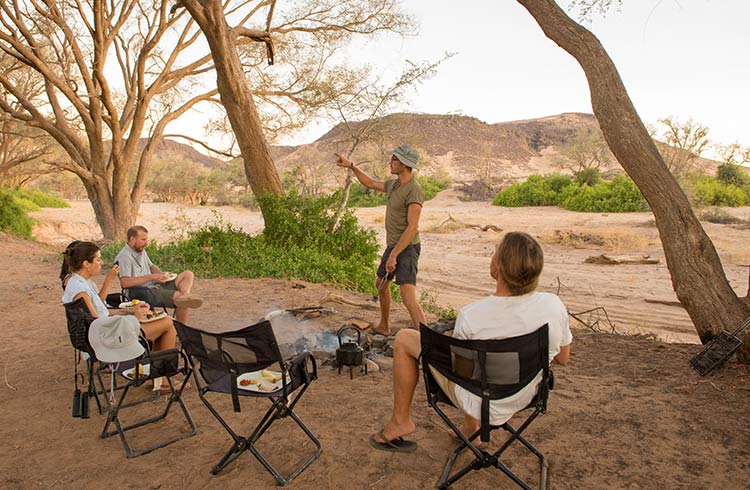
Camping on the Huab River
After a night in the windswept Valley of Desolation, we drive on bumpy tracks to the Huab River. Like most of Namibia’s rivers, the Huab rarely flows with water, and so the “river” is actually a dry, sandy riverbed flanked by trees.
Nevertheless, the foliage and underground water support a remarkable array of birds and wildlife, and after journeying through vast arid areas home to very few animals, coming to the Huab feels like we’ve arrived on safari.
A handful of red-billed spurfowl announce our arrival at our chosen camping spot: on the riverbank under the shade of huge ana trees. We’re sticking to the wild camping rule of never to sleeping in a riverbed in case of flash floods. We park our 4x4s, pop up the rooftop tents, roll out the shade awnings, unfold our camping chairs and metal tables and, in a few minutes, our temporary home is set up.
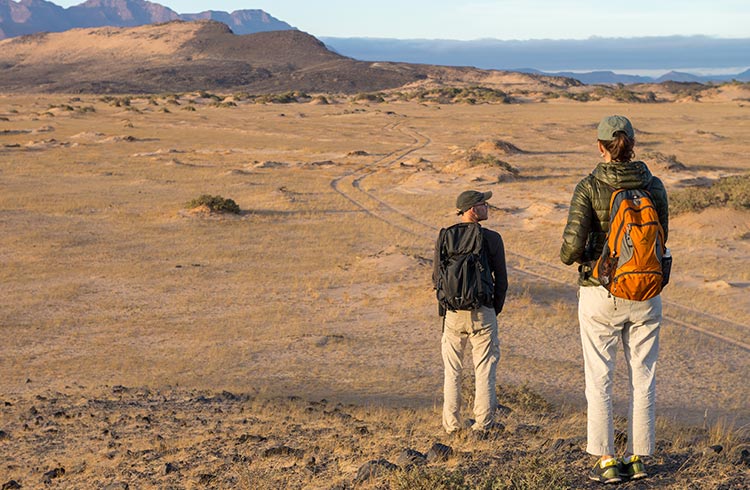
The desert elephants of the Huab
Namibia is one of just two places in the world where you can find desert elephants. These hardy animals have adapted to this extremely dry climate: they can go for days without water and can walk long distances in search of a drink.
Tracking them in this vast region can be tricky, but luck is on our side, as we spot an old bull elephant followed by a family of matriarchs and babies on our first morning, and continue to have thrilling sightings every time we leave camp (while always keeping a respectful distance).
Being in the presence of these gentle giants as they go about eating seedpods and digging for water is enough to awe us into wide-eyed wonder. However, our encounters feel even more remarkable because we’re the only people for miles around – a far cry from your typical safari vehicle pile-up around a sighting.
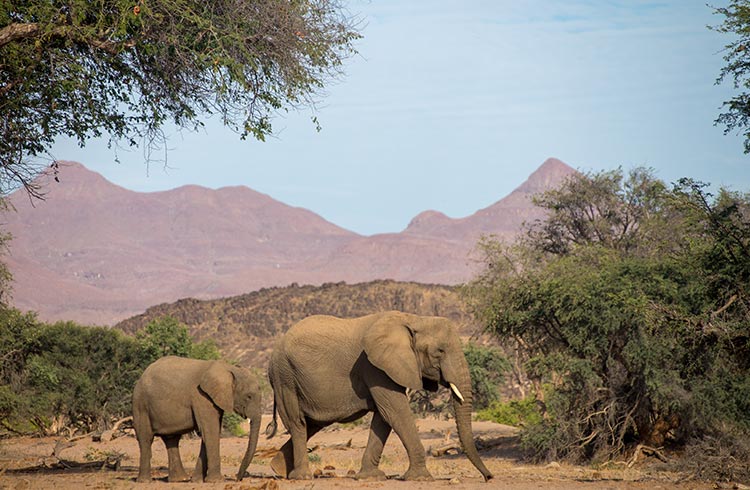
Hiking near the Huab River
Our days fall into an easy routine: each morning we wake just before dawn to walk for hours along the riverbanks and over dunes. We see lots of bird species, as well as kudu, giraffe, duiker, steenbok, families of ostriches and a tiny horned adder hiding under a rock, but my favorite part of exploring on foot is being quietly immersed in the wilderness of the Huab.
The scenery here is remarkably varied and dramatic: camelthorn, mopane and ana trees line the sides of the riverbed, huge sandy valleys are dotted with gigantic boulder outcrops and rocky hills, red-rock mountains punctuate the horizon, and massive sand dunes studded with black volcanic rocks make the elephants walking below them seem tiny. Namibia has some of the most startling landscapes I’ve ever seen, but the Huab is certainly one of the most beautiful and diverse areas in the country I’ve traveled to.
Being so remote and so disconnected from the human world makes this time in nature seem all the more special. Our Namibian road trip is full of highlights, from swimming in the Orange River, and spotting graceful oryx among the orange dunes of the NamibRand Nature Reserve, to exploring the vast, barren Martian landscapes of the Messum Crater and hiking under the jagged peaks around the Ugab River, but our days in the Huab River are the stand out. There’s the birdlife, the wildlife sightings, and the spectacular scenery, but most of all, the wonderful encounters on foot that we share with the desert elephants.
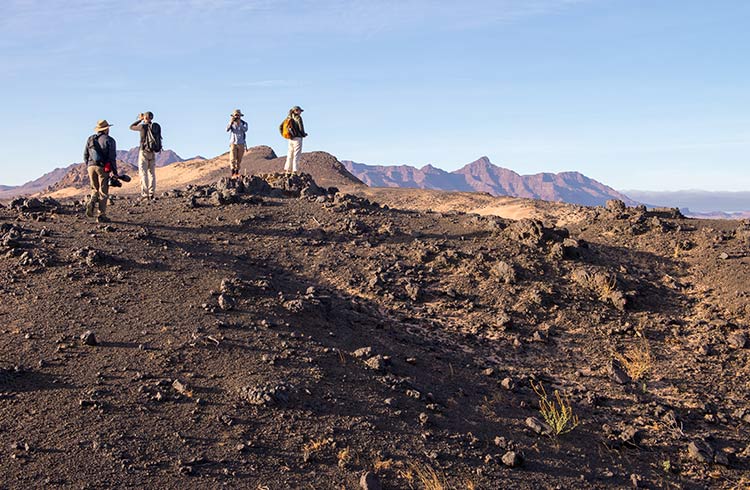
Trip notes
Road tripping Cape Town to Namibia
Starting in Cape Town, our route takes us to the Orange River and then over the border into the NamibRand Nature Reserve, the Namib-Naukluft National Park, Swakopmund, the Messum Crater, the Ugab River, the Valley of Desolation and finally to the Huab River. Driving southwards back to Cape Town, we stay at Spitzkoppe and at the Fish River Canyon.
Our total distance is 4,767mi (7,672km) over 16 days.
Thanks to meticulous meal planning, our food lasts us all the way back to Cape Town – with just one fresh food restock in Walvis Bay.
How to self-drive in remote parts of Namibia
For safety reasons, it’s best to drive in a convoy of at least two vehicles. You should also have a reliable GPS (we used Tracks 4 Africa’s maps), as well as satellite phone for emergencies and a full road recovery kit.
It’s important to preserve the wilderness: take every piece of trash back with you, burn your toilet paper and bury your campfires. Stick to driving on tracks that are already there rather than making new ones.
What to pack
You’ll have to bring everything you need to be fully self-sufficient in the wild, from food, firewood and extra jerry cans of fuel to large containers of water.
Pack lightweight long trousers and long-sleeved shirts to protect your skin from the sun. A wide-brimmed hat, sunglasses, lots of high SPF sunscreen and comfortable walking shoes are essential. Even during the hottest months of summer (November to April), nights in the desert can be windy and cold, so pack layers.
Related articles
Simple and flexible travel insurance
You can buy at home or while traveling, and claim online from anywhere in the world. With 150+ adventure activities covered and 24/7 emergency assistance.
Get a quote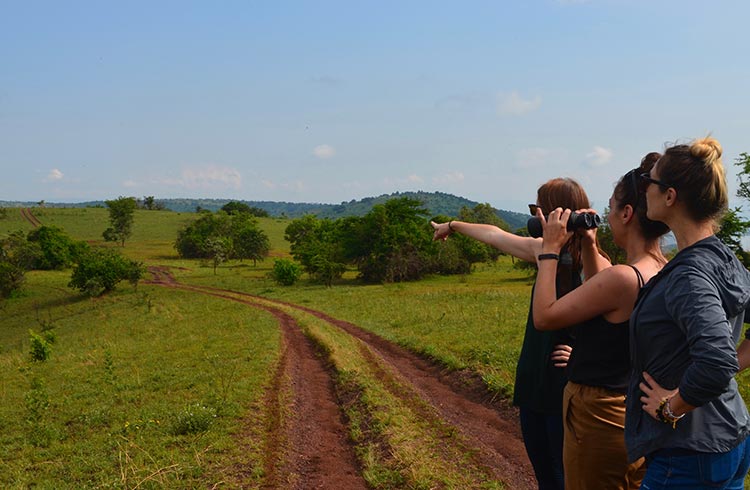
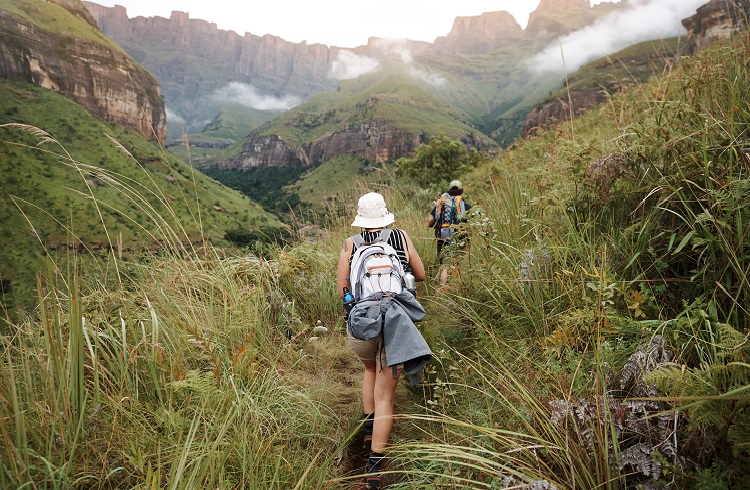
No Comments